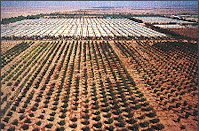|
|
Achievements
 |
The use of modern techniques and machinery enhances fruit orchards (foreground) and greenhouses (background). |
The 1970s marked the beginning of serious agricultural development in the Kingdom. The government launched an extensive program to promote modern farming technology; to establish rural roads, irrigation networks and storage and export facilities; and to encourage agricultural research and training institutions. The result has been a phenomenal growth in the production of all basic foods from 1.79 million tons in 1970 to 2.39 million tons in 1981 and 7 million tons in 1992. Saudi agricultural production was valued at 5 06 billion U.S. dollars in the same year. The increased food production brought about a proportional decline in imports. Between 1981 and 1991, Saudi food imports declined by 43 percent. Saudi Arabia now exports wheat, dates. dairy products, eggs, fish, poultry, vegetables and flowers to markets around the world. Such exports reached 533 million dollars in 1992.
Intensive dairy, meat, poultry and egg farming were all introduced early in the program, and by 1985, local farms were satisfying domestic demand for many products previously imported. Production of poultry and red meat rose from 151,000 tons in 1981 to more than 410,000 in 1992. Egg production rose from 71,000 tons in 1981 to more than 113,000 in 1992, meeting all local demand. The Kingdom now has some of the most modern and largest dairy farms in the Middle East. Milk production rose from 311,000 tons in 1981 to over half a million tons in 1992 -- at a remarkably productive annual rate of 1,800 gallons per cow, one of the highest in the world.
While fish production through traditional off-shore fishing has increased steadily in recent years to more than 56,000 tons in 1992, the Kingdom is exploring ways of further increasing its catch and to encourage greater private investment. One of the new areas in which the private sector is investing with government support is aquaculture. The number of fish farms, either in pens in the sea or in tanks onshore, has been increasing steadily. Most are located along Saudi Arabia's Red Sea coast.
The Kingdom's most dramatic agricultural accomplishment, noted worldwide, has been its rapid transformation from importer to exporter of wheat. In 1978, the country built its first grain silos. By 1984, it had become self-sufficient in wheat. Shortly thereafter, Saudi Arabia began exporting wheat. Production rose from 26,000 tons in 1970 to 416,000 tons in 1981. In 1992, production was estimated at 4.2 million tons. In the major producing areas of Tabuk. Hail and Al-Qasim, average yields have more than quadrupled to 3.6 tons per acre.
Saudi Arabia has exported wheat to 30 countries, including China, the former Soviet Union, nations of the European Economic Community, Indonesia, South Korea, Sri Lanka and various Arab and Islamic countries. Between 1986 and 1992, Saudi Arabia exported approximately 12 million tons of wheat. The Kingdom is not only increasing wheat exports, but it is also stockpiling a reserve supply and has increased its silo capacity to approximately 2.5 million tons. In addition, Saudi farmers grow substantial amounts of other grains such as barley, sorghum and millet.
The Kingdom has also stepped up fruit and vegetable production by improving both agricultural techniques and the roads that link farmers with urban consumers. Saudi Arabia is a major exporter of fruits and vegetables to its neighbors. Among its most productive crops are watermelon, grapes, citrus fruits, onions, squash and tomatoes. At Jizan in the country's well-watered southwest, the Al-Hikmah Research Station is producing tropical fruits including pineapples, paw-paws, bananas, mangoes and guavas.
This agricultural transformation has altered the country's traditional diet, supplying a diversity of local foods unimaginable just a generation ago. Dates are no longer the vital staple for Saudi Arabians that they were in the past, although they still constitute an important supplementary food. Saudi Arabia has approximately nine million, or one-tenth, of the world's productive date palms. Date production grew to more than 543,000 tons in 1992. Much of this is used as international humanitarian aid. Several factories, including one in Al-Hasa, are dedicated entirely to the production of dates for foreign aid and send tens of thousands of tons of dates each year to relieve famine and food shortages in Arab, Islamic and other nations. A large portion of Saudi Arabia's wheat production is also provided as assistance to needy countries. At least 16 countries have directly benefitted from Saudi Arabia's food aid offered through the United Nations World Food Program. The Kingdom is second only to the United States in contributions to the program .
|